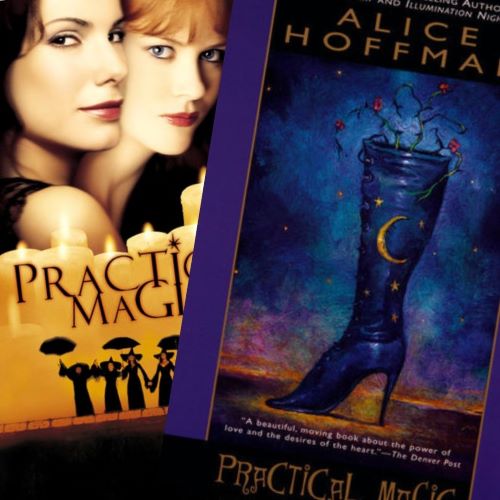
Book v Movie: Practical Magic
I am of the mind that the book is always better. If I’ve read the book (especially if I love the book) then seeing the film adaptation disappoints. However, if I see the movie first, I find that movie holds a special place in my heart that the book just can’t fill. Stardust (book by Neil Gaiman, film starring pretty much everyone) is the best example of this. I love the film so much that the book just fell flat for me. Somehow it lacked the magic of the film. Another great example is Legally Blonde. Despite that the literary Elle Woods is a member of my sorority; the book just didn’t do it for me. It was lacking something the movie managed to have. Something that left me feeling happy and proud, to be both a sorority woman and a blonde. The one exception to this pattern is Practical Magic.
I cannot remember the first time I saw the film, but when I discovered it was a book I bought it immediately. On the train home from my last grad school final, I cracked open Practical Magic. Somehow, even though I love the film, I loved the book even more. During my most recent reread, and reading of the subsequent prequels, I decided to cap it off with a movie rewatch. And thus you have the adaptation analysis you didn’t ask for and never knew you needed (spoilers ahead).
The Book Synopsis
For more than two hundred years, the Owens women have been blamed for everything that has gone wrong in their Massachusetts town. Gillian and Sally have endured that fate as well: as children, the sisters were forever outsiders, taunted, talked about, pointed at. Their elderly aunts almost seemed to encourage the whispers of witchery, with their musty house and their exotic concoctions and their crowd of black cats. But all Gillian and Sally wanted was to escape.
One will do so by marrying, the other by running away. But the bonds they share will bring them back—almost as if by magic…(Goodreads)
The Movie Synopsis
Sally Owens (Sandra Bullock) and Gillian Owens (Nicole Kidman) have always known they were different. Raised by their Aunt Frances (Stockard Channing) and Aunt Jet (Dianne Wiest) after their parents’ death, the sisters grew up in a household that was anything but typical. Their aunts fed them chocolate cake for breakfast and taught them the uses of practical magic. But the invocation of the Owens’ sorcery also carries a price – some call it a curse: the men with whom they fall in love are doomed to an untimely death. Now adult women with very different personalities, the quiet Sally and the fiery Gillian must use all of their powers to fight the family curse and a swarm of supernatural forces that threatens the lives of all of the Owens women(IMDB).
The Setting
The bulk of the book, while it begins in Salem, takes place on Long Island, in a very mundane suburb. I think this gives the book more character, it makes the magic more ‘practical’ (this will be a theme). In the book after Sally loses her husband, she doesn’t move back in with the aunts. She rejects everything having to do with them and magic and takes her daughters away for a normal life. While this doesn’t make for good movie tension, I think it makes the rest of the story more remarkable. And, if you read the prequels, you realize that Sally’s journey to self-acceptance is part of her history. And the idea that they have both rejected and left the Aunts is pivotal to their relationship.
Still, the film set of a small and spooky Massachusetts island is ideal for what the filmmakers were trying to achieve. They sought to take the practice out of the magic and make the whole thing more fantastical. The setting, and the continued presence of the aunts that come with that, is key to hyping up the magic.
The Characters
When watching the film now it’s hard to imagine a movie more packed with ‘before they were famous’ stars. That Sandra Bullock was any bigger of a name than Nicole Kidman, Stockard Channing, or Diane Wiest is surprising. But alas, like with any movie, one big name has to take center stage. This made for different character dynamics than in the book. First, it made Sally the main character and we focused on her love story way more than in the book. Gary, Sally’s “perfect man”, only appears in the last 5th of the novel, while poor Ben (Gillian’s main love interest) got cut out completely.
Additionally, by changing the setting, we were able to get more of the Aunts. And while their characters were spot on, I can’t help but feel they’re there because of the actors who played them (not that I’m complaining). It just changed the nature of the story to shift the focus more actually on one character. There were also some confusing choices, like making the girls younger. In the book, Sally’s daughters Kylie and Antonia, are thirteen and seventeen respectively. That added a layer of angst and dynamics to the story that I felt the movie lacked.
That said, the filmmakers still managed to capture the heart of the story, the relationship between Gillian and Sally, and their increasingly confusing feelings toward their family legacy. While I wanted more out of those characters I loved, Bullock and Kidman were the perfect choices for their roles. They got the heart of the characters, their friendship, and sisterhood, which made up for where the story fell short.
The Story
I fully understand that when adapting a book for the screen some things have to change. Every book lover can lament the loss of their favorite character or storyline but ultimately, for me, if the heart of the story remains, the adaptation will be good. For all changes and cuts, Practical Magic has held on to the core of what the book laid out. The relationship between the two sisters and their acceptance of their true identity.
As I previously mentioned, the thing about Practical Magic that really bothered me was the loss of the practicality. In the novel, magic (in the form of traditions and superstitions, and curses) is abundant within the house, but the Owen’s never cast spells in public the way they do in the movie. That’s what makes the rumors so intense. No one, except the women who come for help, really know if they’re magic. They reiterate that curses only has power if you believe in them, and in the movie, they believe.
Still, the movie succeeded in that, when the final scene happens and all the women in the neighborhood clasp hands; when Sally uses the power of her blood to save Gillian from being possessed, I get chills ( I got chills while writing this). Aunt Frances says, as once skeptical women talk about their own strange premonitions or occurrences, that there’s a little witch in all of us. And that brought it back to the core of this novel. Magic is everywhere, magic is inside each of us. We just have to be brave enough to tap into it. So, despite the jumping off roofs and blatant spell casting, there is something in the film that makes us believe magic is real, and might even be practical.


